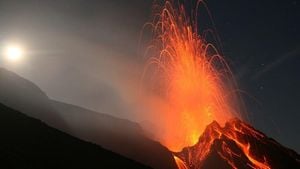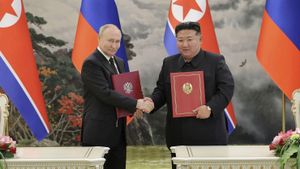The violence gripping Mexico continues to escalate, with chilling reports underscoring the brutal activities of drug cartels, particularly in the northwestern state of Sinaloa. The nation has seen at least ten new fatalities over the recent weekend alone, including disturbing incidents where the corpses were found adorned with sombreros or with pizza slices brutally stabbed onto them. These grotesque acts seem to showcase the deep-seated animosity between rival factions within the Sinaloa Cartel, making the streets of Culiacan increasingly unsafe for residents.
Historically, the Sinaloa Cartel has held considerable power within Mexico's drug trade. But the tables have turned since the unexpected arrest of co-founder Ismael “El Mayo” Zambada on U.S. soil at the end of July. His capture has sparked chaos among the ranks, igniting violent power struggles as factions align either with Zambada or El Chapo's progeny, eager to take the reins of the cartel’s considerable operations. Since September 9, officials and media accounts have recorded close to 70 killings, primarily concentrated within Culiacan, the state capital.
This surge of violence is not just random. On one Saturday, clashes erupted between security forces and alleged cartel henchmen as they engaged in gunfire. During the confrontation, police were ambushed, prompting chaos as unknown assailants created blockades with vehicles near the prosecutor's office. Later, security agents faced attacks from gunmen who fled to nearby apartment buildings, resulting in the deaths of several suspects and injuries to soldiers on duty, as detailed by Governor Ruben Rocha Moya through social media updates.
Rocha has been proactive, stating, "The security forces managed to evacuate six adults and one child from the property where the aggressors were taking refuge.” Such incidents are becoming the norm, raising questions about the effectiveness of security measures currently deployed. The federal government acknowledged the alarming situation by dispatching 600 additional soldiers to reinforce security operations across Sinaloa, indicating the severity of the conflict.
The recent spate of violence relays messages of intimidation, with grizzly scenes becoming symptomatic of the cartels' extreme tactics. Bodies found stripped or half-dressed, wearing hats, and torturously displayed signify the brutality of warfare between competing factions. Such acts, where corpses are left on the streets or displayed within vehicles, have increasingly incorporated cultural symbols like sombreros and pizzas, which are now morbid markers of cartel warfare.
The unsettling dynamic behind these recent events revolves around the dissatisfaction and retaliatory violence stirring among cartel members loyal to the notorious figures, Zambada and El Chapo. The latter, still imprisoned, remains influential through his children who are wading through the murky waters of their father’s legacy. Joaquin Guzman Lopez, El Chapo’s son, was also apprehended alongside Zambada during his arrest, pulling both sides of the cartel's hierarchy tighter together under unrelenting scrutiny.
Yet, beyond the gore thrives the political maneuvering. President Andrés Manuel López Obrador has sought to deflect some blame, asserting Mexico’s internal crisis is exacerbated by the actions of the United States, especially concerning Zambada's capture. U.S. ambassador Ken Salazar, on the defensive, challenged this notion, stating, "It is incomprehensible how the United States can be responsible for the massacres we see in different places." This tug-of-war over culpability highlights the complex interplay between governmental actions and cartel violence.
Adding to the backdrop, Zambada recently pleaded not guilty at his trial set to take place in New York. He faces serious charges including engagement in torture and orchestrated murder plots as his influence and control over the cartel are put on trial. Meanwhile, the streets of Culiacan bear witness to the violent churnings of cartel wars, pointing toward looming instability and continuing bloodshed as factions vie for dominance.
The situation remains fluid, and as violence surges with no clear resolution on the horizon, the Mexican government faces significant challenges to restore safety and order within its borders. Escalated military presence reflects the awareness of how dire the situation has become, yet for residents caught amid the conflict, the anticipation of yet another wave of violence looms large.
With Zambada's case and the brutal events across Sinaloa still unraveling, the residents can only watch and wait, hoping for some semblance of peace amid the bloodshed around them. Regardless of who emerges at the top of this catastrophic power play, it is crystal clear: the powerful forces driving cartel violence will continue to redefine the safety and stability of life in Mexico.



